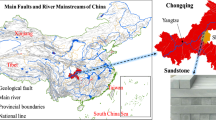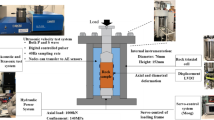Abstract
Currently, using the finite difference method to simulate millimeter-sized fractures in formations requires intensive calculations. However, only the time domain characteristics of the calculated borehole acoustic signal are often analysed, while the frequency domain characteristics are ignored. This study aims to obtain the time-frequency characteristics of full acoustic waveforms in different types of fractured formations while reducing operational time and to analyze more comprehensively the influence of fractures on time-frequency characteristics. Therefore, the variable grid finite difference method is used to simulate full acoustic waveforms in boreholes in formations with millimeter-sized horizontal fractures to reduce the computational time of the finite difference method. Afterwards, the wavelet transform is used to analyze the influence of fracture width, fracture number, and radial extension length on the waveform time-frequency characteristics. The results show that with increasing fracture width or number, the P- and S-wave arrival times are delayed, amplitude attenuation is enhanced, and the dominant frequency increases gradually. The frequency and amplitude attenuation of each Stoneley wave component also increases, and the arrival time of the 20–28 kHz high-frequency Stoneley wave is delayed. When the fracture radial length is limited, an increase in radial length delays the P- and S-wave arrival times, and the amplitude attenuation increases. The main S-, Stoneley, and pseudo-Rayleigh wave frequencies increase, and the Stoneley wave and pseudo-Rayleigh wave amplitude attenuation increases. When the fracture radial length is infinite, the P-wave and pseudo-Rayleigh wave amplitude attenuation increases, whereas that of the S-wave and Stoneley wave decreases. This study reveals the influence of fractures on the time-frequency characteristics of full acoustic waveforms in boreholes, provides a theoretical basis for the time-frequency analysis of full acoustic waveforms, and is significant for further clarification of the propagation characteristics of borehole acoustic waves in fractured formations.
Similar content being viewed by others
References
Berenger J.P., 1994. A perfectly matched layer for the absorption of electromagnetic waves. J. Comput. Phys., 114, 185–200
Bertrand J., and Bertrand P., 1992. A class of affine Wigner functions with extended covariance properties. J. Math. Phys., 33, 2515–2527
Chen Y.H., Chew W.C. and Liu Q.H., 1998. A three-dimensional finite difference code for the modeling of sonic logging tools. J. Acoust. Soc. Am., 103, 702–712
Chew W.C. and Liu Q.H., 1996. Perfectly matched layers for elastodynamics, a new absorbing boundary condition. J. Comput. Acoust., 4, 341–359
Chew W.C. and Weedon W.H., 1994. A 3D perfectly matched medium from modified Maxwell’s equations with stretched coordinates. Microw. Opt. Tech. Lett., 7, 599–604
Cohen L., 1966. Generalized phase-space distribution functions. J. Math. Phys., 7, 781–786
Collino F. and Tsogka C., 2001. Application of the perfectly matched absorbing layer model to the linear elastodynamic problem in anisotropic heterogeneous media. Geophysics, 66, 294–307
Condon E.U., 1937. Immersion of the Fourier transform in a continuous group of functional transformation. Proc. Natl. Acad. Sci. U. S. A., 23, 158–164
Cong J., Chen D. and Song Y., 2004. Finite-difference modeling of the acoustic field in the borehole in cylindrical coordinates. J. Daqing Petrol. Inst., 28, 11–14 (in Chinese with English abstract)
Dai N., Vafidis A. and Kanasewich E.R., 1995. Wave propagation in heterogeneous, porous media: A velocity-stress, finite-difference method. Geophysics, 60, 327–340
Gabor D., 1946a. Theory of communication. Part 1: The analysis of information. Journal of the Institution of Electrical Engineers — Part III: Radio and Communication Engineering, 93, 429–441
Gabor D., 1946b. Theory of communication. Part 2: The analysis of hearing. Journal of the Institution of Electrical Engineers — Part III: Radio and Communication Engineering, 93, 442–445
Gabor D., 1946c. Theory of communication. Part 3: Frequency compression and expansion. Journal of the Institution of Electrical Engineers — Part III: Radio and Communication Engineering, 93, 445–457
Graves R.W., 1996. Simulating seismic wave propagation in 3D elastic media using staggered-grid finite differences. Bull. Seismol. Soc. Amer., 86, 1091–1106
Huang N.E., Shen. Z. and Long S.R., 1998. The empirical mode decomposition and the Hilbert spectrum for nonlinear and non-stationary time series analysis. Proc. R. Soc. London Ser. A-Math. Phys. Eng. Sci., 454, 903–995
Komatitsch D. and Martin R., 2007. An unsplit convolutional perfectly matched layer improved at grazing incidence for the seismic wave equation. Geophysics, 72, SM155-SM167
Kurkjian A.L. and Chang S.K., 1986. Acoustic multipole sources in fluid-filled boreholes. Geophysics, 51, 148–163
Levander A.R., 1988. Fourth-order finite-difference P-SV seismograms. Geophysics, 53, 1425–1436
Lin W., Wang X. and Zhang H., 2006. Acoustic wave propagation in a borehole penetrating an inclined layered formation. Chinese J. Geophys., 49, 284–294 (in Chinese with English abstract)
Liu L., Zhang C., Cai M., He Y., Hua Y. and Liu Y., 2019. Studies on the effec of crack on the propagation of acoustic waves in wellbore. Geophys. Geochem. Explor., 43, 1333–1340 (in Chinese with English abstract)
Liu Q. H., Schoen E., Daube F., Curt R. and Ping L., 1996. A three-dimensional finite difference simulation of sonic logging. J. Acoust. Soc. Am., 100, 72–79
Ma Y., Yu J. and Wang Y., 2014. A novel unsplit perfectly matched layer for the second-order acoustic wave equation. Ultrasonics, 54, 1568–1574
Madariaga R., 1976. Dynamics of an expanding circular fault. Bull. Seismol. Soc. Amer., 66, 639–666
Morlet J., Arenst G., Fourgeau E. and Giard D., 1982. Wave propagation and sampling theory-part I: complex signal and scattering in multilayered media. Geophysics, 47, 203–221
Ou W. and Wang Z., 2019. Simulation of Stoneley wave reflection from porous formation in borehole using FDTD method. Geophys. J. Int., 217, 2081–2096
Ou W., Wang Z. and Ning Q., 2019. Numerical simulation of borehole Stoneley wave reflection by a fracture based on variable grid spacings method. Acta Geophys., 67, 1119–1129
Randall C.J., Scheibner D.J. and Wu P.T., 1991. Multipole borehole acoustic waveforms: Synthetic logs with beds and borehole washouts. Geophysics, 56, 1757–1769
Schmitt D.P., Bouchon M. and Bonnet G. 1988., Full-wave synthetic acoustic logs in radially semiinfinite saturated porous media. Geophysics, 53, 807–823
Stephen R.A., Cardo-Casas F. and Cheng C.H., 1985. Finite-difference synthetic acoustic logs. Geophysics, 50, 1588–1609
Tsang L. and Rader D., 1979. Numerical evaluation of the transient acoustic waveform due to a point source in a fluid-filled borehole. Geophysics, 44, 1706–1720
Wang T. and Tang X., 2003. Finite-difference modeling of elastic wave propagation: A nonsplitting perfectly matched layer approach. Geophysics, 68, 1749–1755
Zhao H., Wang X. Wang D. and Chen H, 2007. Applications of the boundary absorption using a perfectly matched layer for elastic wave simulation in poroelastic media. Chin. J. Geophys., 50, 581–591 (in Chinese with English abstract)
Acknowledgments
This research was supported by the Natural Science Foundation of Xinjiang Uygur Autonomous Region (2017D01B08), Scientific Research Planning Project of Xinjiang Uygur Autonomous Region (XJEDU2017S056), Tianchi Doctor Research Project of Xinjiang Uygur Autonomous Region (BS2017001), Xinjiang Uygur Autonomous Region Tianshan innovation team project (2020D14014), Xinjiang Key Laboratory of Geohazard Prevention (XJDX1715), and Key Laboratory of Mine Advanced Geological Exploration and Safety Prediction of Xinjiang Institute of Engineering.
Author information
Authors and Affiliations
Corresponding author
Rights and permissions
About this article
Cite this article
Xiang, M., An, R. & Qi, X. Numerical simulation and time-frequency analysis of borehole acoustic logging in fractured formations. Stud Geophys Geod 67, 60–82 (2023). https://doi.org/10.1007/s11200-021-1145-y
Received:
Revised:
Accepted:
Published:
Issue Date:
DOI: https://doi.org/10.1007/s11200-021-1145-y




